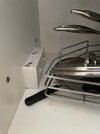- Joined
- 26 Mar 2020
- Messages
- 97
- Reaction score
- 13
- Country

Afternoon all
My 2008 integrated Bosch dishwasher has finally died and I have to replace it.
I’m considering just going for a freestanding one this time. Apparently they are 60cm vs 59.8cm for integrated but pretty sure it will fit.
One question though. My old integrated one was hard wired. I’m assuming it would be the case of removing the plug and wiring up the old connection. An electrician would do this though pretty sure with power off I could do it!
Am I missing anything? Cheers for any input.
My 2008 integrated Bosch dishwasher has finally died and I have to replace it.
I’m considering just going for a freestanding one this time. Apparently they are 60cm vs 59.8cm for integrated but pretty sure it will fit.
One question though. My old integrated one was hard wired. I’m assuming it would be the case of removing the plug and wiring up the old connection. An electrician would do this though pretty sure with power off I could do it!
Am I missing anything? Cheers for any input.



